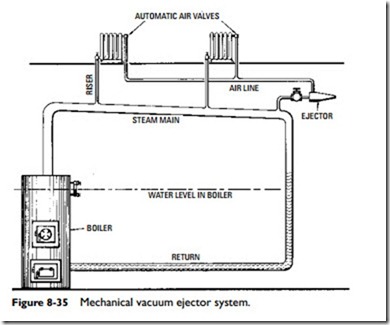Mechanical Vacuum System
A mechanical vacuum system is one in which an ejector or pump is used to maintain the vacuum. The hookup of the ejector system is shown in Figure 8-35. The ejector, which may be operated either by steam or water, is started before steam is turned on in the sys- tem. Thus, after the air is removed, steam quickly fills the heat- emitting units, because the air is automatically removed as fast as it accumulates.
The system commonly used in exhaust heating employs an alleged or so-called vacuum pump, which ejects the air and condensate from
the system. In operation, this device pumps out most of the air (or other gas) from the condenser, maintaining a partial vacuum. The pump cannot obtain a perfect vacuum because each stroke of the pump piston or plunger removes only a certain fraction of the air, depending on the percentage of clearance in the pump cylinder, resistance of valves, and so forth. Hence, theoretically an infinite number of strokes would be necessary to obtain a perfect vacuum (not considering resistance of the valves, clearance, etc.).
Condensation of steam creates the vacuum, and the pump that removes the air maintains a vacuum. A wet pump (that is, one that removes both air and condensate) is the type generally used. A dry pump removes only the air.
The essential features of a mechanical vacuum pump system are shown in Figure 8-36. This system is of the fractional valve distribution type. In operation, air, being heavier than steam, passes off through thermostatic retainer valves to the pump. When the steam reaches the retainer valves, they close automatically to
prevent the steam passing into the dry return line to the pump and breaking the vacuum. The condensate is pumped from the receiver back into the boiler by a feed pump and passes on its way through a feed water heater, where it is heated by the exhaust steam from the air and feed pumps.

